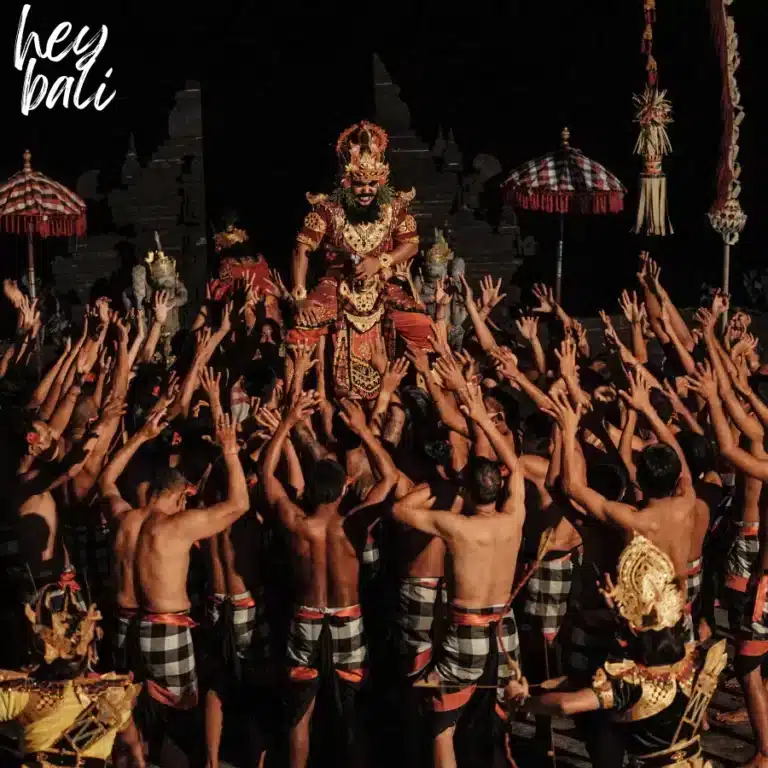Chapters
Toggle“Om Swastiastu meaning” goes way deeper than your yoga retreat’s “Namaste”—and if you mess it up in Bali, you’ll get the politest side-eye of your life.
The Greeting That Confuses Every Tourist
Your first temple visit. A priest walks by radiating wisdom. You blurt “Hello!” like you’re at Starbucks. His smile freezes. The old ladies giggle behind their offerings. Suddenly, you realize: You just committed Bali’s most common cultural oopsie.
“I thought I was being respectful… until a 10-year-old Balinese kid gently schooled me on proper greetings.” — Matt, Canadian backpacker turned Om Swastiastu evangelist

Here’s why this matters:
- Every local uses it—but 90% of tourists miss it
- It’s not just “hi”—it’s a blessing packed into 4 syllables
- Get it right, and doors open (literally—we’re talking hidden ceremonies, grandma’s home cooking invites)
Fun Fact: Even Google Translate fails at this one. Type “Om Swastiastu” and it suggests “Om Sweet Astu”… which sounds like a yoga-themed dessert café.
🧳Read : Suksma, Bali! How to Say Thank You Like a Local
〰️🌀〰️🌀〰️🌀〰️
What Does Om Swastiastu REALLY Mean? – Om Swastiastu meaning
Let’s cut through the insta-spiritual BS. Om Swastiastu meaning isn’t some touristy catchphrase—it’s a 1,200-year-old prayer condensed into a greeting. Think of it as Bali’s original blessing emoji.

The Word-by-Word Magic (That Most Guides Won’t Tell You)
- “Om” = The universe’s hum (same cosmic vibration as India’s “Om”)
- “Swasti” = Sanskrit for harmony/safety (Fun fact: Hitler ruined the swastika—but Bali kept its pure meaning)
- “Astu” = “May it be” (Like “amen”, but with more coconut oil)
Literal translation: “May divine harmony be with you”
Real-deal meaning: “I see the god in you, let’s not mess up this good vibe”
When to Drop Your Om Swastiastu Like a Pro – Om Swastiastu meaning
| ✅ DO Use It Here | ❌ DON’T Use It Here | 🔥 Pro Tip |
|---|---|---|
| Temples (Even Instagram hunters get a pass) | Beach clubs (“Apa kabar?” works better with cocktails) | Say it when receiving tirta (holy water) |
| Ceremonies (From baby blessings to cremations) | Kids under 12 (They’ll giggle and reply “Hello Mister!”) | Extra sembah points if elders hold offerings |
| Greeting priests/elders (Especially in traditional dress) | Warungs (Unless the grandma gives you that wise look) | Match their bow depth – don’t overdo it! |
| Village ceremonies (When you’re the only foreigner) | After 3+ Bintangs (Sacred + slurred = bad karma) | Morning hours = best reception |
Why This Greeting is Bali’s Secret Handshake – Om Swastiastu meaning
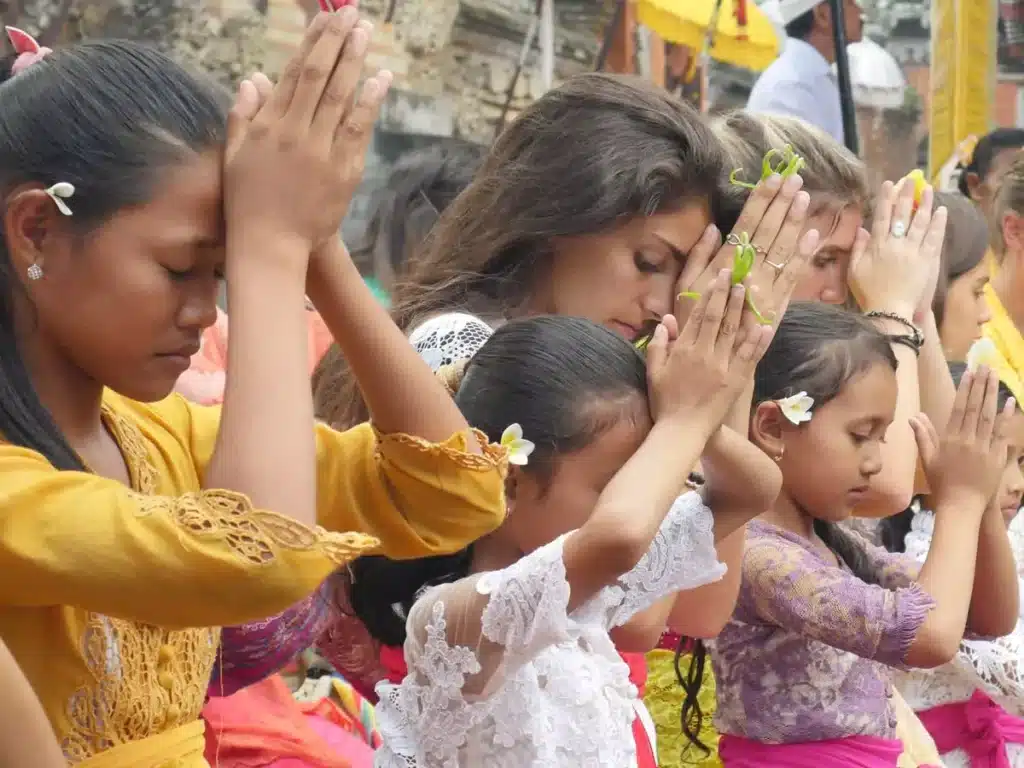
- It’s NOT Hindu-lite like “Namaste”—this is Tri Hita Karana philosophy in action (Balinese harmony doctrine)
- Get it right, and suddenly:
- Priests might explain temple carvings to you
- Grandmas slip you banana leaf snacks
- Shopkeepers stop giving you “tourist price”
“Used Om Swastiastu at a tooth-filing ceremony—next thing I know, I’m invited to the family’s post-ritual feast.” — Sophie, French expat
The Tourist Trap Most Fall Into
Google “spiritual greetings in Bali” and you’ll find flowery nonsense. Here’s the raw truth locals won’t tell you:
⚠️ Mispronounce it as “Om Swasti-ass-too” and you’ve just wished someone “divine harmony in the butt” (true story).
Pro Tip: Listen to how flower vendors say it at Pura Saraswati—their inflection is gold.
🧳Read : Ampura – How to Say “Sorry” in Balinese
〰️🌀〰️🌀〰️🌀〰️
Om Swastiastu vs Namaste: Bali’s Spiritual Flex
Let’s settle this spiritual showdown once and for all. Om Swastiastu vs Namaste isn’t just wordplay – it’s like comparing a bespoke Balinese temple offering to a mass-produced yoga studio incense stick. Both smell nice, but only one holds ancient magic.
The Great Hindu Greeting Divide

🇮🇳 Namaste (The Tourist Classic):
- Indian/Hindu universal greeting
- Means “The divine in me bows to the divine in you”
- Perfect for:
- Yoga studios in Brooklyn
- Your hippie aunt’s meditation room
- Instagram captions under sunset pics
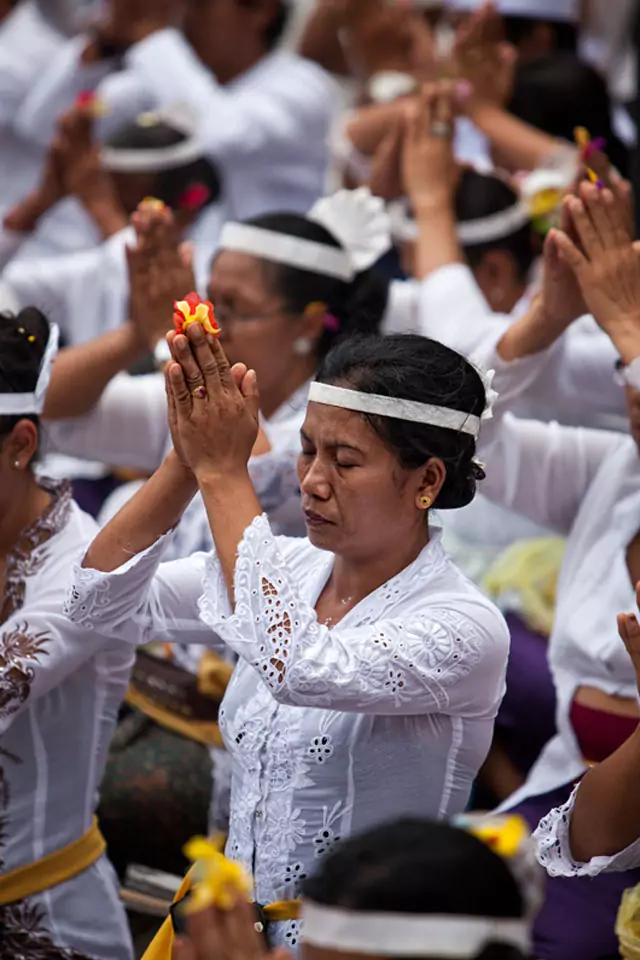
🇮🇩 Om Swastiastu (Bali’s OG Blessing):
- Exclusive to Balinese Hinduism
- Rooted in Tri Hita Karana (the island’s sacred harmony trinity)
- Translation: “May divine balance bless your human, nature, and god relationships”
- Works for:
- Temple priests who’ve been chanting since 5AM
- Tooth-filing ceremonies (where your bad karma gets filed too)
- Impressing your Balinese mother-in-law
“Using Namaste in Bali is like ordering spaghetti at a warung – it works, but the aunties will whisper about you.” – Ketut, Ubud local guide
When Namaste Accidentally Works in Bali
There’s one situation where Namaste won’t get you side-eyed:
✅ When speaking to Indian Hindus at Bali’s few Indian temples (like Pura Agung Jagatnatha)
For everyone else? Om Swastiastu or bust.
Why This Matters More Than You Think – Om Swastiastu meaning
Get this wrong and you’ll:
- Look like a “spiritual tourist” (the cringiest species in Bali)
- Miss out on real connections (locals light up when you use their greeting)
- Potentially offend high priests (whose side-eye could curdle coconut oil)
Pro Tip: Watch how Balinese greet each other at Pura Desa village temples – their body language (slight bow, hands at heart) says more than words.
🧳Read : Bali Hindu Offerings: More Than Just Pretty Baskets
〰️🌀〰️🌀〰️🌀〰️
How to Nail the Om Swastiastu Delivery (Without Looking Like a Try-Hard)
Let’s be real – nothing screams “tourist” louder than butchering Om Swastiastu with the enthusiasm of a kindergarten holiday play. Here’s how to ace it like you’ve been blessing people since your past Balinese life.
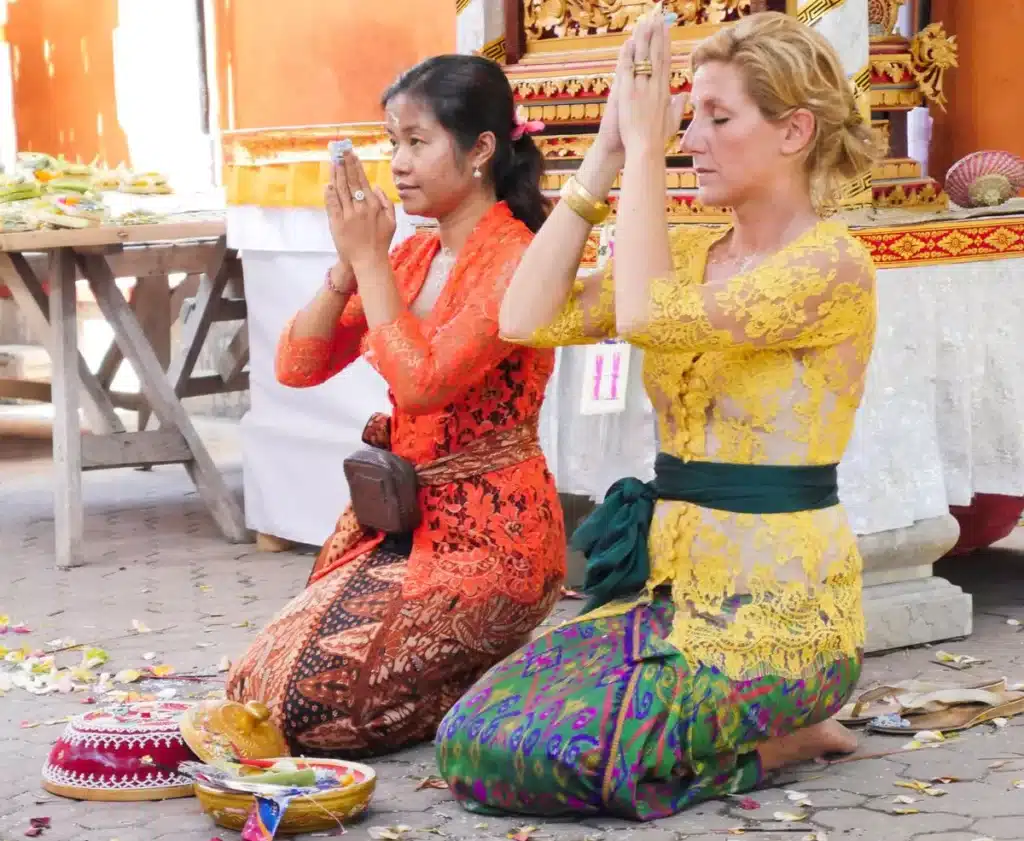
The Pronunciation Hack Most Miss
| Syllable | Sounds Like | Don’t Say | Why It Matters |
|---|---|---|---|
| Om | “Ohm” (like yoga class) | “Um” or “Am” | Sets the sacred tone |
| Swas | “Swass” (soft “a”) | “Swaaaz” (like jazz) | Balinese hate harsh “z” sounds |
| Tee | Quick “tea” | Drawn-out “tay” | Keeps it prayer-like, not sing-song |
| Ahs | Open “ah” (like “spa”) | “Ass” (please no) | Avoids accidental insults |
| Too | Soft “to” (not “two”) | “Tuuu” (like a ghost) | Ends the blessing gently |
🔊 Listen & Learn: The 3-Second Om Swastiastu Breakdown (Click play below!)
Pro Tip: The rhythm should feel like a wave – “Om… Swas-tee-ahs-too” (not choppy: “Om. Swas. Tee. Ahs. Too.”).
“Say it like you’re exhaling a blessing, not reciting a WiFi password.” – Giostanovlatto, Founder Hey Bali
Pro Tip: Practice at Pura Saraswati‘s lotus pond – the acoustics make you sound legit even if you’re 50% faking it.
Body Language: The Unspoken Rules – Om Swastiastu meaning
Your mouth says “Om Swastiastu” but your body screams “clueless foreigner” if you:
- Over-bow like a Japanese business meeting (15-degree tilt max)
- Crush your hands together like praying for Wi-Fi (gentle sembah position)
- Make eye contact like a nervous job interviewee (soft gaze at their chin)
Golden Ratio:
- See a local/temple priest
- Pause walking
- Hands to heart (no higher than sternum)
- Say greeting + micro-bow
- Smile like you didn’t just overthink all this

When NOT to Drop Your Om Swastiastu
🚫 Beach clubs (“Apa kabar?” + a peace sign keeps the vibe right)
❌ Warung owners (They’ll think you’re mocking them – stick to “Selamat pagi/siang”)
🚫 Kids under 12 (They’ll laugh and reply “Hello Mister!” – it’s adorable)
Exception: If a child in temple attire greets you first with Om Swastiastu, respond in kind – it’s their culture test for you.
Why This Matters More Than You Think
Nail this and:
- Temple gates open literally (priests love respectful foreigners)
- Prices drop at art markets (“Oh you know Om Swastiastu? Local price for you!”)
- Ceremony invites happen (“You come my house for Galungan!”)
“After 6 months of perfecting my Om Swastiastu, my Balinese neighbor finally stopped calling me ‘Bule’ and used my name.” – Elena, Italian expat
🧳Read : Gods, Rituals & Offerings: What Religion in Bali Really Looks Like
〰️🌀〰️🌀〰️🌀〰️
Cultural Faux Pas to Avoid: When Your Om Swastiastu Backfires
You’ve mastered the pronunciation, nailed the sembah – but one wrong move and your perfect Om Swastiastu becomes as awkward as a vegan at a babi guling feast. Here are the landmines to avoid:

The Sacred Greeting Hall of Shame
🚫 “Om Swastiastu” + Temple Shorts
- What you think: “My denim cutoffs show off my yoga-toned legs!”
- What locals see: A walking insult to the gods
- Fix: Sarong rental stands exist for a reason (Rp10k saves your spiritual cred)
❌ Blessing with a Bintang in Hand
- Scenario: Sunset at Tanah Lot, beer in left hand, “Om Swastiastu” with right
- Why it fails: You’re basically blessing while flipping off the universe
- Pro Move: Chug first, greet later (or switch to holy water)
🚫 Forcing It on Unprepared Locals
- Classic Fail: Greeting your scooter rental guy like he’s a high priest
- Reality Check: If they lead with “Hello!”, just mirror them
- Exception: Temple priests, ceremony officiants, and your Balinese mother-in-law
The Invisible Rules No Guidebook Mentions – Om Swastiastu meaning

🔇 Volume Control:
- Whispering it = you’re ashamed
- Shouting it = you’re performing
- Goldilocks zone: Say it like you’re telling a secret to the universe
👗 Outfit Hierarchy:
- White temple clothes? Greet everyone
- Bikini cover-up? Stick to nods
- Full ceremonial gear? You’re now obligated to bless foreigners back
“Saw a tourist say Om Swastiastu while taking a selfie at Pura Besakih… the priest’s face said ‘I’ll pray for your soul.'” – Gede, Klungkung local
Why These Rules Aren’t Just Nitpicking
Break them and you’ll:
- Become “that tourist” in village gossip
- Miss out on real cultural exchanges
- Potentially disrupt actual ceremonies (yes, we’ve seen it happen)
Silver Lining: Locals appreciate the effort – they’ll gently correct you rather than scold (unless you’re naked at Pura Tirta Empul).
🧳Read : Denpasar’s Hidden History: 6 Time-Travel Experiences for Culture Nerds
〰️🌀〰️🌀〰️🌀〰️
Why Om Swastiastu is Your Golden Ticket to the Real Bali
Think of Om Swastiastu as your backstage pass to the Bali that Google Maps can’t show you. This isn’t just about being polite – it’s about cracking the cultural code that separates tourists from temporary locals.
The Magic That Happens When You Get It Right


A. Instant “Bule to Bro” Status Upgrade
- That stoic temple guardian? Suddenly explaining carvings to you
- The warung owner? Secret family recipe suddenly “available for special friend”
- Pro Tip: Use it when receiving canang offerings – watch eyes light up
B. Ceremony VIP Access
- Normal tourists: Stand behind ropes
- You: Om Swastiastu + proper sembah = Invited to help carry offerings
- “I went from spectator to participant at a Ngaben ceremony just by greeting the priest correctly.” – Liam, UK Digital Nomad
C. The Price Drop Phenomenon
- Before: “300,000 for sarong, special price for you!”
- After: “50,000… you know Om Swastiastu? For you, 40,000”
Beyond Tourism: The Respect You Didn’t Know You Were Missing
- At Hotels: Staff stop calling you “Sir” and start calling you “Bli” (bro)
- In Villages: Kids stop shouting “Hello Mister!” and actually answer your questions
- At Temples: Priests might just bless you without the “donation” hint
The Hidden Bonus: It works even if your pronunciation isn’t perfect. The effort alone shouts “I care” louder than any phrasebook ever could.
Real Talk: When One Word Changes Everything
“Used Om Swastiastu at a family compound – next thing I know, I’m learning to make offerings and being invited for Kuningan feast. Six years later, they’re my Balinese family.” – Sarah, Australian Expat
Pro Move:
- Learn three basic Balinese phrases (including this one)
- Use them only when appropriate (see Section 5)
- Watch how your entire Bali experience transforms
Final Showdown: Tomorrow we’re pitting Om Swastiastu against 10 other Balinese phrases in our “Cultural Greeting Battle Royale” – may the most powerful blessing win.
🧳Read: Need help with left behind items in Bali? Free and Sincere Help from Hey Bali
〰️🌀〰️🌀〰️🌀〰️
FAQ: Om Swastiastu Questions You’re Too Embarrassed to Ask (But Google Secretly)
These are the questions tourists whisper after temple tours – answered with the straight tea no guidebook will give you.
Hell yes – if you mean it. Balinese culture thrives on respectful participation, not spectator status.
Pro Tip: The more you butcher the pronunciation, the more they appreciate you tried. It’s like watching a baby deer walk – awkward but endearing.
Option 1: Echo it back like a spiritual call-and-response
Option 2: Smile + slight bow if you’re tongue-tied
Never: High-five or “Hey bro!” (unless it’s your Balinese surf instructor)
Less offensive, more “Oh honey no” cringe. Like:
Saying “Om Sweet-ass-too” = spiritual oopsie
Using it at Potato Head Beach Club = cultural facepalm
Damage Control: A sincere “Maaf, saya belajar” (Sorry, I’m learning) fixes 99% of blunders.
Nope. Balinese Hindus love when visitors honor their traditions. Think of it like:
Italians hearing you attempt “grazie”
Japanese people when you nail “arigato”
→ Universal warm fuzzies
Three likely reasons:
You pronounced it like a sneeze (“Om Swasti-ACHOO”)
You used it while holding a giant Bintang
You’re a 6’4″ Viking-looking dude saying it to a 4-year-old
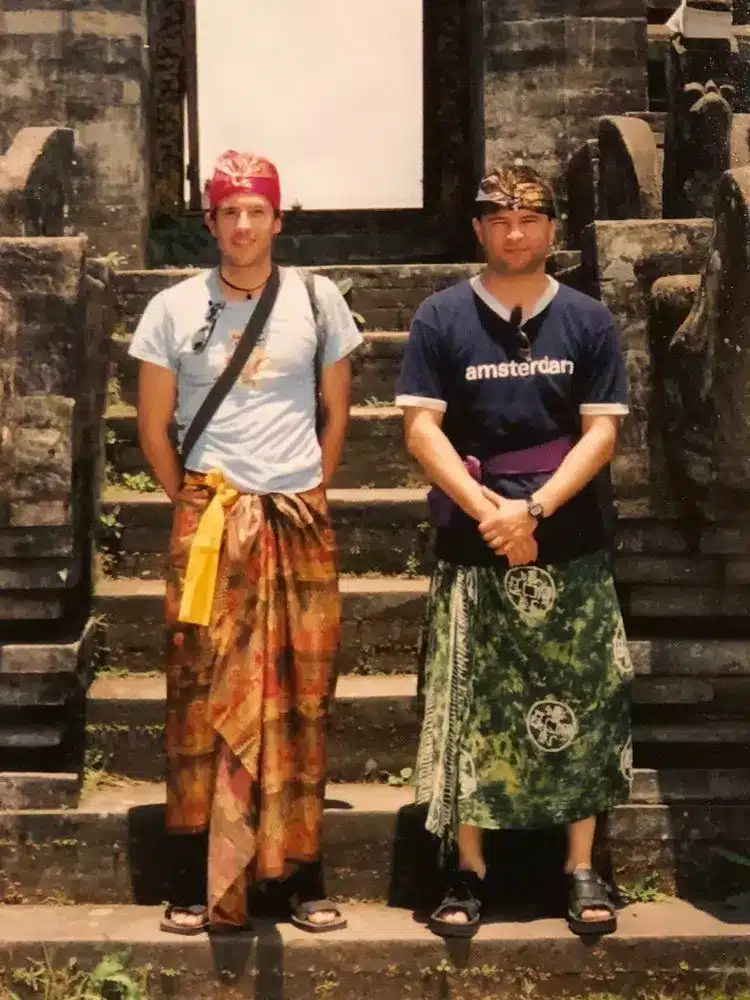
BONUS: The Question No One Asks (But Should) – Om Swastiastu meaning
“Can I teach my friends back home to use this?”
Sure – if you also teach them:
- When not to use it (Zoom calls ≠ temple ceremonies)
- The sembah hand position (no jazz hands)
- That Bali ≠ India (“Namaste” won’t cut it)
👍Read: Transform Your Spirit: 3 Must-Visit Melukat Temples in Bali
〰️🌀〰️🌀〰️🌀〰️
From Om Swastiastu to Cultural Insider – Om Swastiastu meaning
You’ve got two choices:
- Keep stumbling through cultural interactions like a baby deer on temple stairs
- Let real priests teach you the sacred greetings even most expats never master
Hey Bali’s Sacred Rituals Tour gives you:
✔ Om Swastiastu masterclass from temple priests (not your yoga instructor)
✔ Behind-the-scenes ceremony access where these greetings actually matter
✔ The subtle nods/handshakes hierarchy (when to switch from sacred to casual)
“Your Bali experience won’t transform until your greetings do. We’ll get you there in 4 hours flat.” – Ketut, Head Culture Guide
Read : Best SIM Cards & eSIMs for Fast, Reliable Internet in Bali
〰️🌀〰️🌀〰️🌀〰️

Meet the Author
Giostanovlatto is a self-proclaimed “professional wanderluster” who believes that life is too short to stay in one place. When he’s not busy chasing sunsets or hunting for the best local food, you can find him striking up conversations with strangers (who often become friends by the end of the trip).


























































